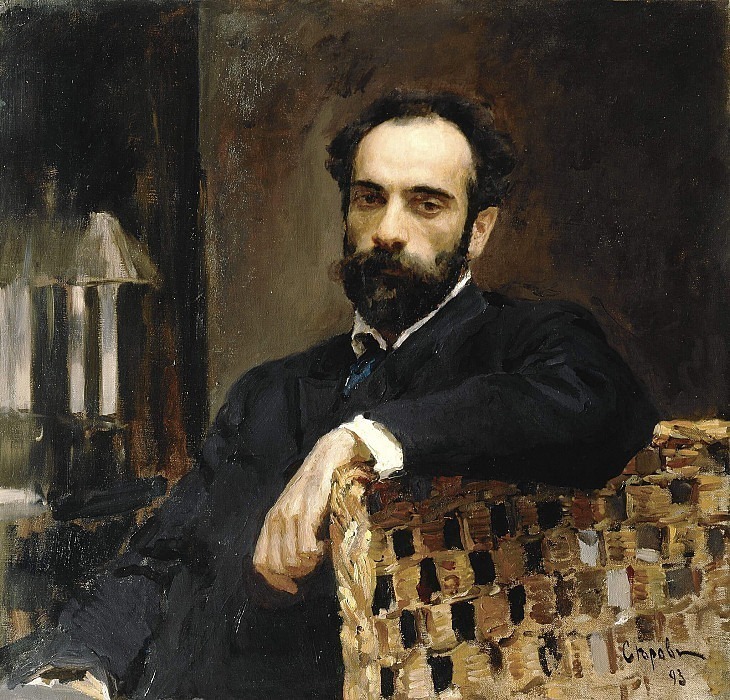Portrait of the artist I.I. Levitan Valentin Serov (1865-1911)
Valentin Serov – Portrait of the artist I.I. Levitan
Edit attribution
Download full size: 2048×1966 px (0,6 Mb)
Painter: Valentin Serov
Location: The State Tretyakov Gallery, Moscow (Государственная Третьяковская галерея).
It has long been a well-known method for one artist to paint another. They often do this so they don’t lie to each other. Or simply to show themselves in different genres. Levitan rarely turned to portrait work, but Serov did more often and was an acknowledged master of portraiture. By the way, he painted a lot and paints and pencils portraits of his children, relatives and close friends. He did it wonderfully, and even so many years later one can only wonder how beautiful, believable and almost easy a portrait the author could make.
Description of Valentin Serov’s Portrait of the Artist Levitan
It has long been a well-known method for one artist to paint another. They often do this so they don’t lie to each other. Or simply to show themselves in different genres. Levitan rarely turned to portrait work, but Serov did more often and was an acknowledged master of portraiture. By the way, he painted a lot and paints and pencils portraits of his children, relatives and close friends.
He did it wonderfully, and even so many years later one can only wonder how beautiful, believable and almost easy a portrait the author could make. And in general, the art of painting can be cruel, but it can also be flattering. Can give joy and upset for life.
Serov did not particularly seduce his customers for portraits, he immediately stipulated the condition of truthfulness and reliability of the depicted person on the canvas. And never once this rule is not changed. In fact, some other painters followed his example. The same Levitan, though he painted rarely portraits, tried not to lie to himself and the people.
And here before us is one of the works of Serov. Levitan died early by our standards, and we can say that this portrait was created when his fame was at its zenith and could have shone even longer, but alas, death does not spare even the famous.
It is worth paying attention to the tired look. But this fatigue is not from life, but probably from the work, from the intense labor, not to be penniless and be able to feed his family. Levitan in the portrait is still young, but the wisdom in his eyes is extraordinary. Even the pose itself is not chosen by chance - we see the artist’s hand, his long fingers. These are the hands of a true master of his craft, to which Levitan devoted his entire life.
High forehead, bushy eyebrows and thick beard - all this gives us an even closer look at his eyes. Longing, fatigue, wisdom and life - not a simple life "cocktail" of the painter.
Кому понравилось
Пожалуйста, подождите
На эту операцию может потребоваться несколько секунд.
Информация появится в новом окне,
если открытие новых окон не запрещено в настройках вашего браузера.
You need to login
Для работы с коллекциями – пожалуйста, войдите в аккаунт (open in new window).
















You cannot comment Why?
The background is dark and somewhat indistinct, with a suggestion of a lamp or window on the left side. The overall mood of the portrait is one of quiet contemplation and introspection.
The subtext of the painting could relate to the artists inner world and his perception of himself. The direct gaze and the solemn expression might suggest a sense of self-awareness and perhaps even melancholy. The dark colors and the subdued lighting contribute to a somber atmosphere. The woven chair could symbolize comfort or perhaps confinement, depending on interpretation. The signature С. С. and the year 93 are visible in the lower right corner, indicating the artist and date.
The painting Portrait of the artist I.I. Levitan is a work by Konstantin Korovin, painted in 1893. It depicts the renowned Russian landscape painter Isaac Levitan. Korovin was a close friend and colleague of Levitan, and this portrait is considered a significant representation of Levitans artistic personality and the often melancholic undertones of his work and life. The painting captures Levitans intensity and his reflective nature, characteristic of his artistic output.